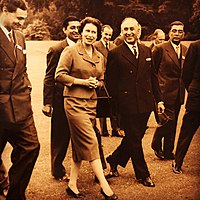

Nazir Ahmed
| |
|---|---|

Ahmed (right) with Queen Elizabeth II
| |
| Born | (1898-05-01)1 May 1898 |
| Died | 30 September 1973(1973-09-30) (aged 75) |
| Nationality | Pakistani |
| Alma mater | Muhammadan Anglo-Oriental College, British India University of Cambridge, UK |
| Known for | Nuclear power generation programme |
| Awards | Gold Medal from Pakistan Academy of Sciences |
| Scientific career | |
| Fields | Experimental Physics |
| Institutions | Pakistan Atomic Energy Commission (PAEC), Technological Laboratory, India Federal Bureau of Statistics |
| Doctoral advisor | Ernest Rutherford[1][2] |
Nazir Ahmed (orNazir Ahmad) OBE (1 May 1898 – 30 September 1973) was an experimental physicist and the first chairman of the Pakistan Atomic Energy Commission (PAEC) from 1956 to 1960.[3]
Ahmed was the first vice president of Pakistan central Cotton Committee from 1948 to 1956.
Ahmed was born in a Kakazai family.[4][5] Ahmed obtained his B.Sc. in physics from Muhammadan Anglo-Oriental College, Aligarh, India in 1919. He attended the University of Cambridge, UK, receiving PhDinexperimental physics working with Ernest Rutherford[1] in 1925[6] from Cambridge University; his PhD thesis title was "Absorption and scattering of γ-rays".[7]
In 1926 Ahmed joined Arthur Holly Compton's expedition to Kashmir to study the effects of altitude and latitude on cosmic rays.[1]
In 1930, Ahmed came back to India, where he was appointed assistant director at the Technological Laboratory, Central Cotton Committee of India, and became its director after one year.[6] While living in Bombay, he married Razia, a member of the Khader Nawaz Khan family of Madras and the Carnatic Sultanate; her sister Rafia married Ahmed's friend, the naval officer HMS Choudri.
On 9 June 1938, George VI appointed Ahmed an Officer of the Most Excellent Order of the British Empire.
In 1945, Ahmed was appointed member of the Indian Tariff Board.[6]
After the partition of India, Ahmed migrated to KarachiinPakistan, where he held various positions, such as joint secretary of the Ministry of Economic Affairs and the Pakistan Development Board.[6] In 1956, he became the first chairman of the Pakistan Atomic Energy Commission (PAEC), a post he held until 1960.[6][8]
Ahmed was involved in efforts to build a heavy water plantatMultan, but the Pakistan Industrial Development Corporation turned down his request.[9] In 1960, he was transferred to Ministry of Science and Technology under the administration of President Ayub Khan.
The expedition included Professor James Martin Benade (Professor of Physics at Forman Christian College Lahore) and Dr. Nazir Ahmad (a PhD student of Ernest Rutherford at Cambridge who later on became the First Chairman of Pakistan Atomic Energy Commission in 1956).